The Roseburg Receiver Helps Bring New GMRS Repeater and Regional Safety Upgrades to Douglas County
The Roseburg Receiver is partnering with local radio operators to launch a new GMRS repeater on Mount Nebo, expanding emergency communication across Douglas County. This project will bring together repeaters across southern Oregon, keeping communities connected when other systems fail.
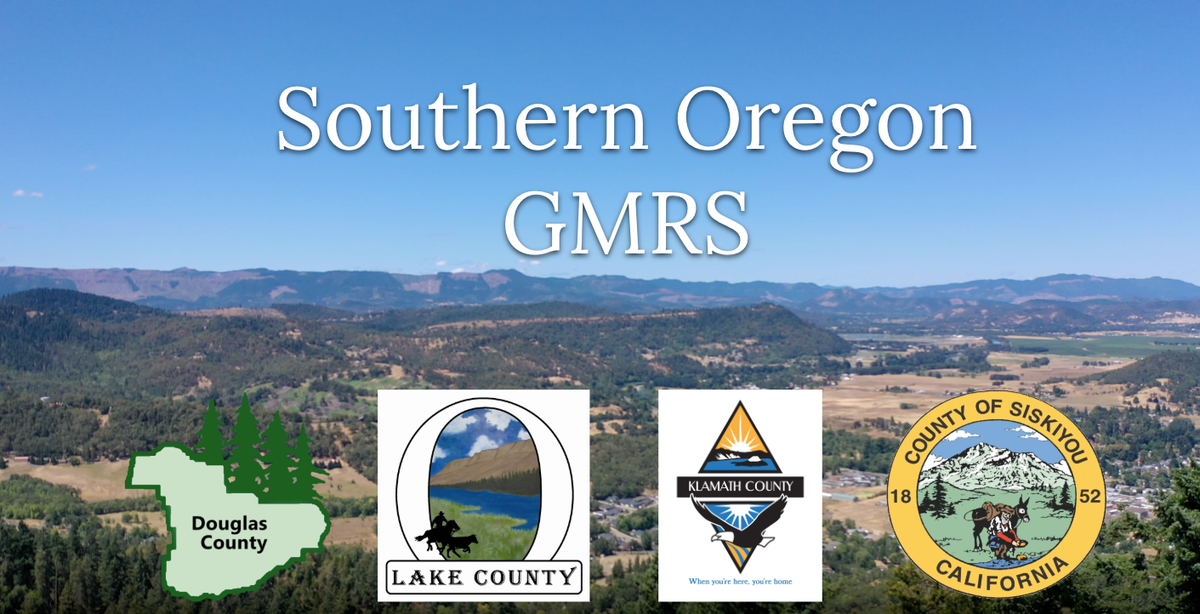
DOUGLAS COUNTY, Ore. — October 18, 2025 — When disaster strikes, communication is often the first thing to fail. Cell towers go down, internet connections stop working, and the devices we depend on most suddenly become useless. Thanks to a growing network of GMRS radio repeaters, our community is taking control of its own safety and building a system that can keep people connected when everything else goes dark.
What GMRS Is and Why It Matters
GMRS, which stands for General Mobile Radio Service, is a federally licensed radio service that allows everyday people to communicate over significant distances. Unlike simple walkie-talkies that work only within a short range, GMRS uses repeaters: powerful relay stations placed on towers or hilltops. These repeaters receive a radio signal and re-transmit it over a much larger area.
A handheld GMRS radio might only reach a mile or two on its own. But when that same radio connects to a repeater on elevated terrain, its range expands dramatically, often stretching dozens of miles. With multiple repeaters covering different areas, conversations can travel across entire regions, all without relying on phones, internet, or cellular service.
Getting a GMRS license is simple. There is no technical exam. Anyone can apply online through the Federal Communications Commission, pay a one-time fee of $35, and receive a license valid for ten years. That license also covers your entire immediate family.
A New Repeater on Mount Nebo Will Transform Local Coverage
For the past several years, a GMRS repeater has operated above downtown Roseburg thanks to the generosity of local radio enthusiast Dale Beaty (call sign WRTX950). Dale has spent years helping build and maintain repeater networks across southern Oregon and northern California. Although the current site has served the community well, its hillside location limits its effectiveness, especially for people using small handheld radios.
That is about to change. Dale and his team now have the opportunity to install a new repeater near the summit of Mount Nebo at about 1,450 feet elevation. The site already has power, secure building space, and existing towers, making it ideal for radio equipment. From this vantage point, the repeater’s signal will reach far beyond the city, covering Roseburg, Winston, Sutherlin, Green, and long stretches of the Interstate 5 corridor.
The system will also feature a battery backup, ensuring it stays on the air even during power outages, a crucial feature during disasters.
Coverage maps show that even basic handheld radios will reach much farther from this location. Anyone using a mobile antenna or higher-power radio will experience even greater range and reliability.
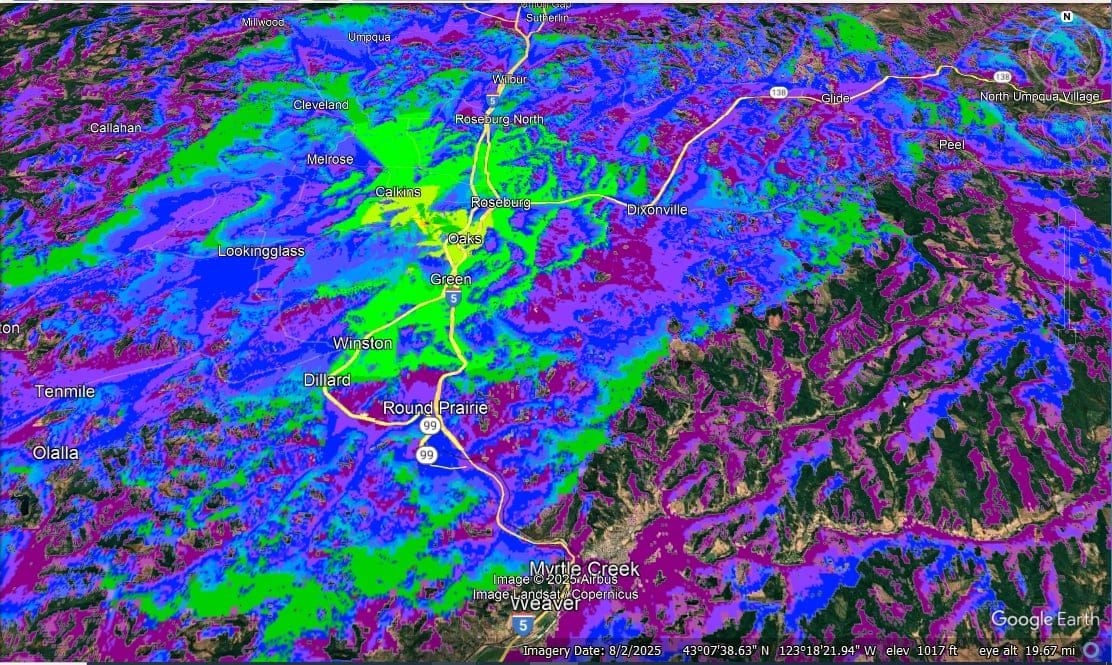
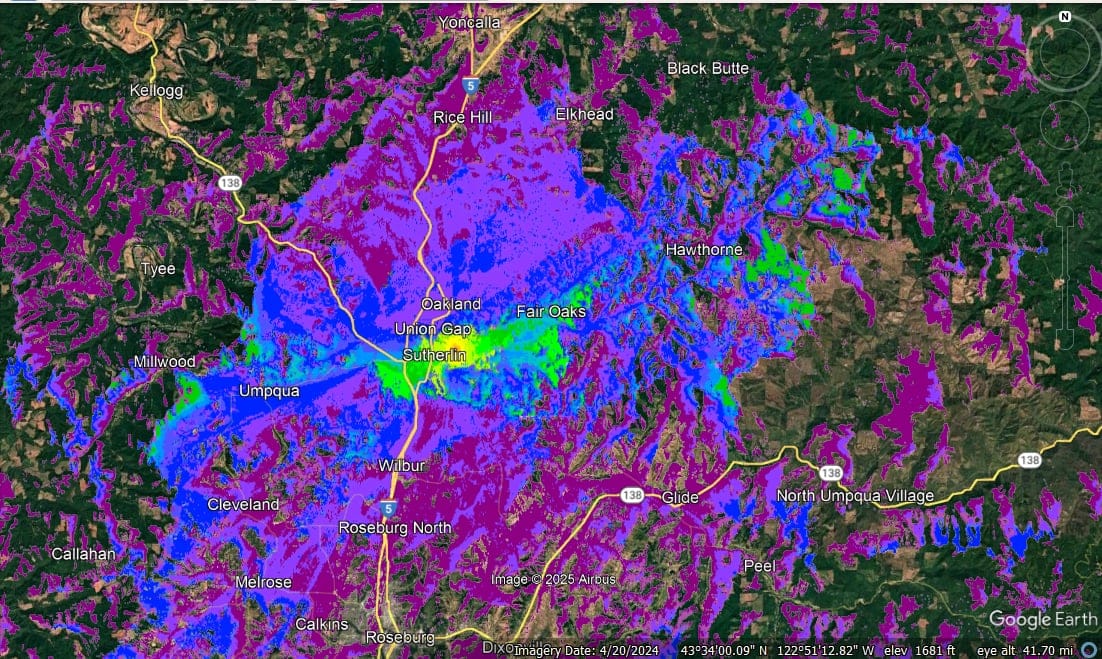
Expanding Regional Coverage
The Mount Nebo project is not just about one site, it’s part of a coordinated effort to expand GMRS coverage across southern Oregon and northern California. Dale’s existing repeaters already serve Douglas, Klamath, Lake, and Siskiyou counties, and additional sites are being added over time. Together, these repeaters will allow communities across the region to communicate even when phones and the internet are unavailable.
This type of system can be vital during wildfires, winter storms, earthquakes, or tsunamis, when traditional communication networks fail. Neighborhood groups, volunteer responders, and families will still be able to talk to one another and share life-saving information.
Skywarn Integration and Live Emergency Alerts
All of Dale’s repeaters are part of the Skywarn emergency information system. This means that weather alerts, fire warnings, earthquake notifications, tsunami advisories, and even beach hazard statements are automatically broadcast over the air every hour, and every 15 minutes if there’s active emergency information.
Right now, Douglas County repeaters are already broadcasting a Beach Hazard Statement. Dale can even remotely command the repeater to read the full NOAA Weather Service emergency message aloud, giving listeners vital details without needing internet or power.
A Homegrown Effort with Deep Local Roots
This initiative is more than a technical project, it’s a homegrown effort led by local people who care deeply about their community. One of those people is Joseph Ziegler, founder of The Roseburg Receiver, who grew up in the Umpqua Valley. Having spent his life in Douglas County, Joseph understands firsthand how vulnerable rural communities can be when communication systems fail. That experience drives his passion for building tools that keep people informed and connected, especially during emergencies.
Joseph is also an experienced and licensed radio operator. He has held his amateur radio (ham) license for over 10 years, reaching radio operators in 22 countries so far around the world. In addition to his amateur license, he also holds a GMRS license (WSHD308), which allows him to support and participate directly in the expanding community repeater network that’s helping improve emergency communications across the region.
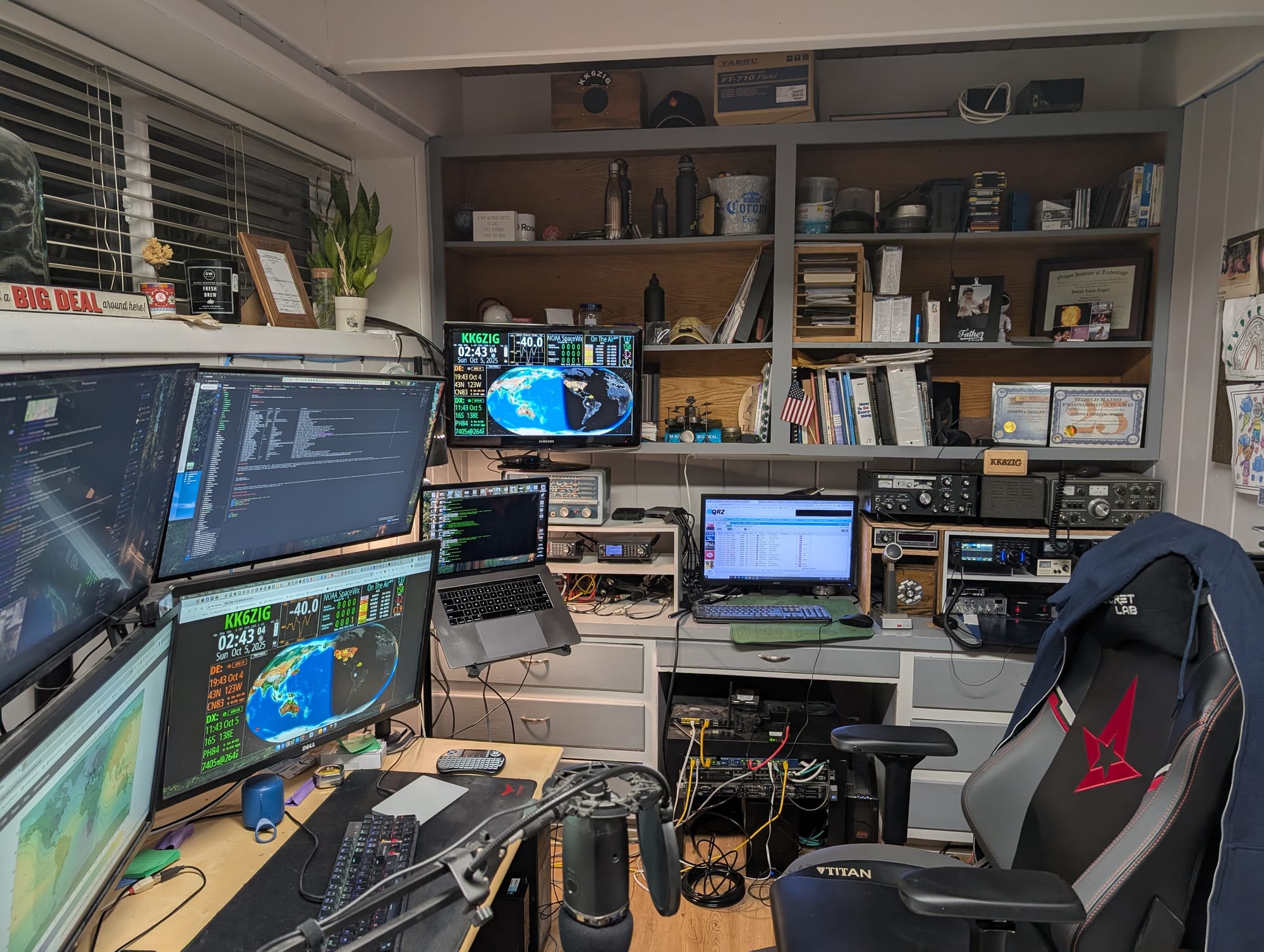
How The Roseburg Receiver and Project Skywatch Are Involved
The new GMRS repeater will share its location with Project Skywatch, an initiative by The Roseburg Receiver to install a high-definition, remotely controlled camera system on Mount Nebo. The camera will monitor the Umpqua Valley for signs of smoke, severe weather, and other emergency conditions, providing a real-time view of what’s happening on the ground.
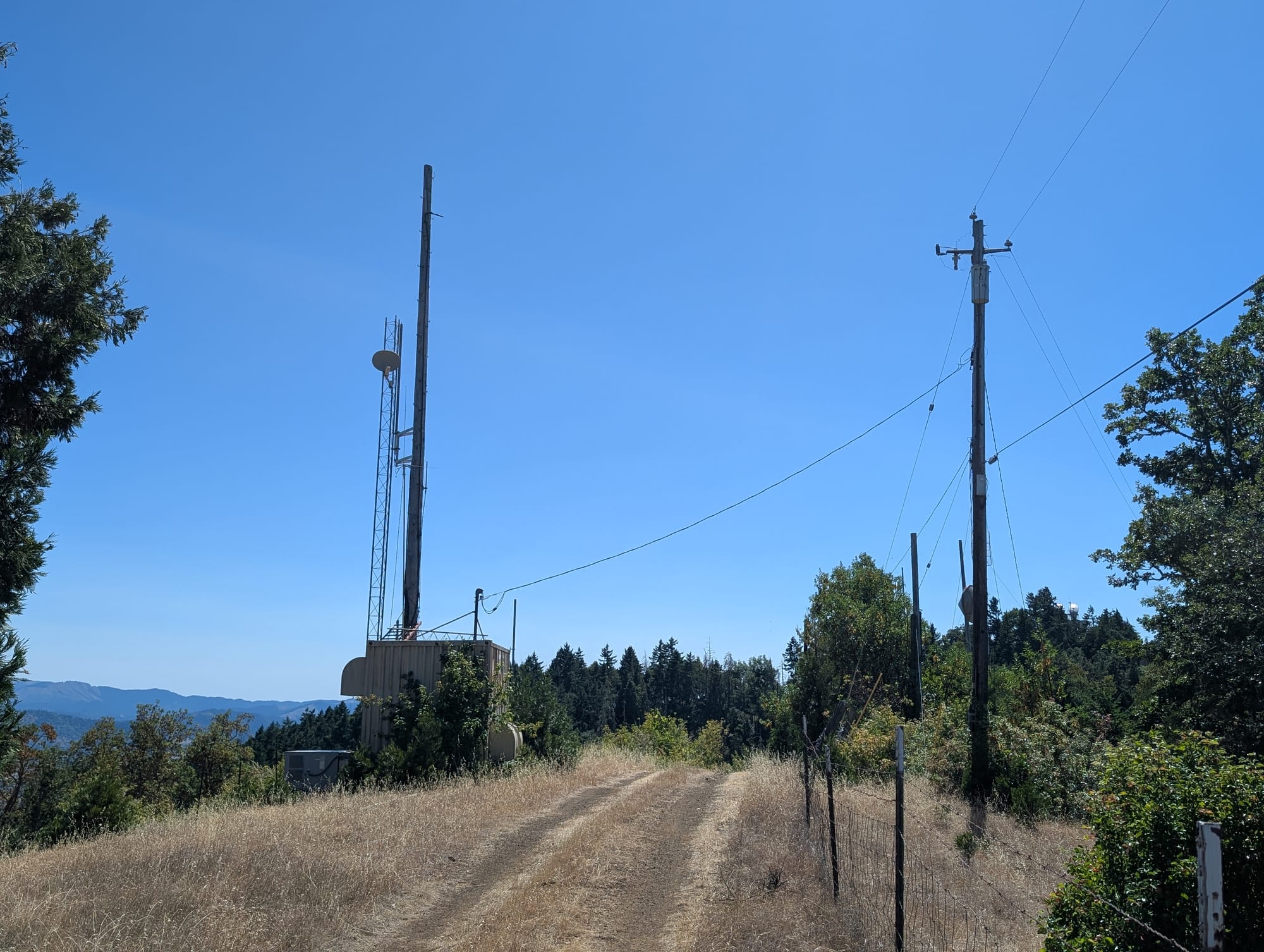
Together, the GMRS repeater and Project Skywatch form a powerful public safety tool: the camera provides eyes on the horizon, and the repeater provides a voice for the community. Both projects are designed to support emergency response, improve coordination, and keep people informed when every second counts.
Frequencies and How to Connect
The repeaters currently operating in Douglas County include:
- Roseburg Repeater:
- Frequency: 462.575 MHz
- Tone: 606N (DCS Receive and Transmit)
- Offset: 5 Mhz
- Sutherlin Repeater:
- Frequency: 462.550 MHz
- Tone: 127.3Hz (CTCSS Receive and Transmit)
- Offset: 5 Mhz
How to Get Involved
Getting started with GMRS is easy:
- Get a License: Apply online through the FCC Universal Licensing System. The cost is $35 and the license is valid for ten years. No test is required, and your entire family is included.
- Get a Radio: Handheld GMRS radios are affordable and widely available. For extended range, consider a mobile radio or a base antenna.
- Join the Community: Once the Mount Nebo repeater is online, you can take part in regular check-ins, learn how to use the system, and help strengthen the network.
- Support the Effort: Donations help fund repeater equipment, maintenance, and expansion. Contributions also support Project Skywatch, which shares the same site.
A Stronger and More Resilient Future
The Mount Nebo GMRS project is about more than radios, it’s about people coming together to solve a real problem. It’s about creating a safety net that doesn’t depend on commercial infrastructure. It’s about building trust, cooperation, and resilience before the next emergency happens.
With The Roseburg Receiver, Project Skywatch, and a growing GMRS system all working toward the same goal, Douglas County is building a communication network that will serve and protect its people for many years to come.
✅ Learn more about Project Skywatch: https://www.roseburgscanner.com/project-skywatch
✅ Donate to support repeater equipment: remoteeditorddb@gmail.com (mark your donation as “Contribution for Radio Equipment Repairs”)
✅ Questions about the GMRS system, contact Dale: wrtx950@gmail.com
✅ Start your GMRS journey: FCC Universal Licensing System

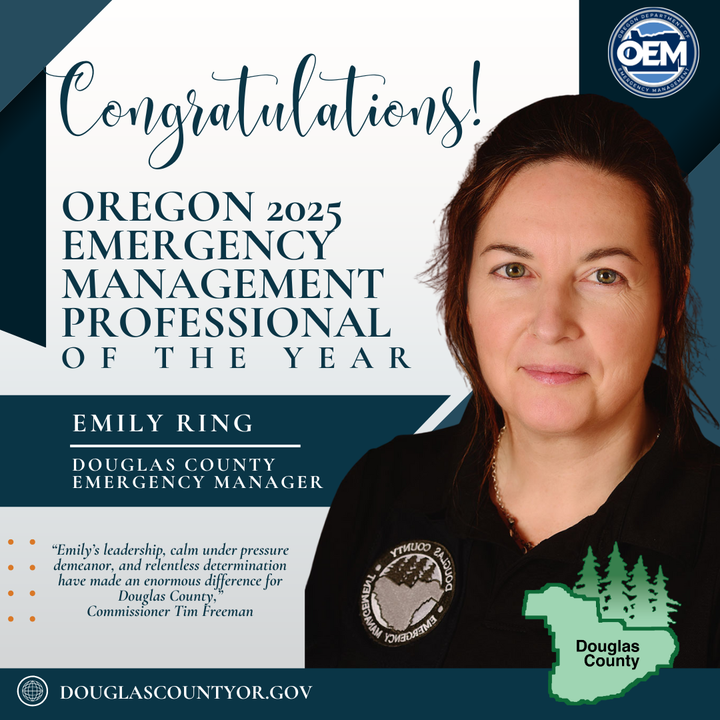


Comments ()